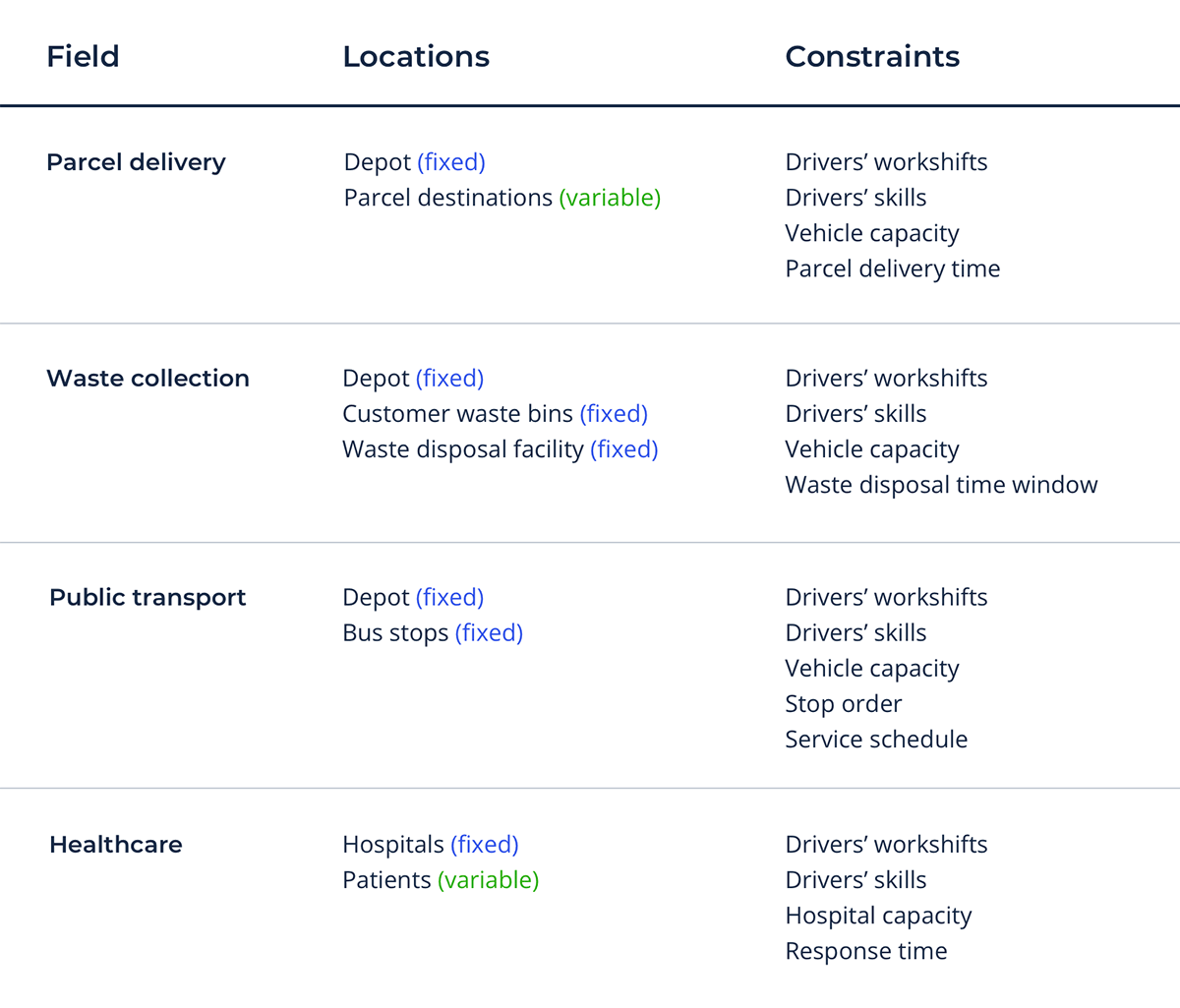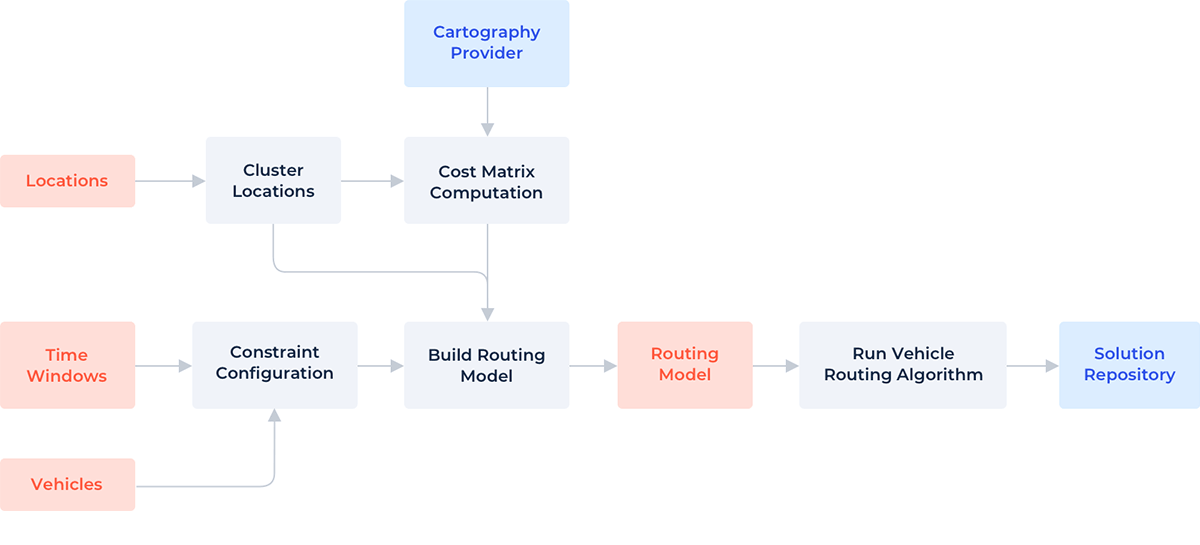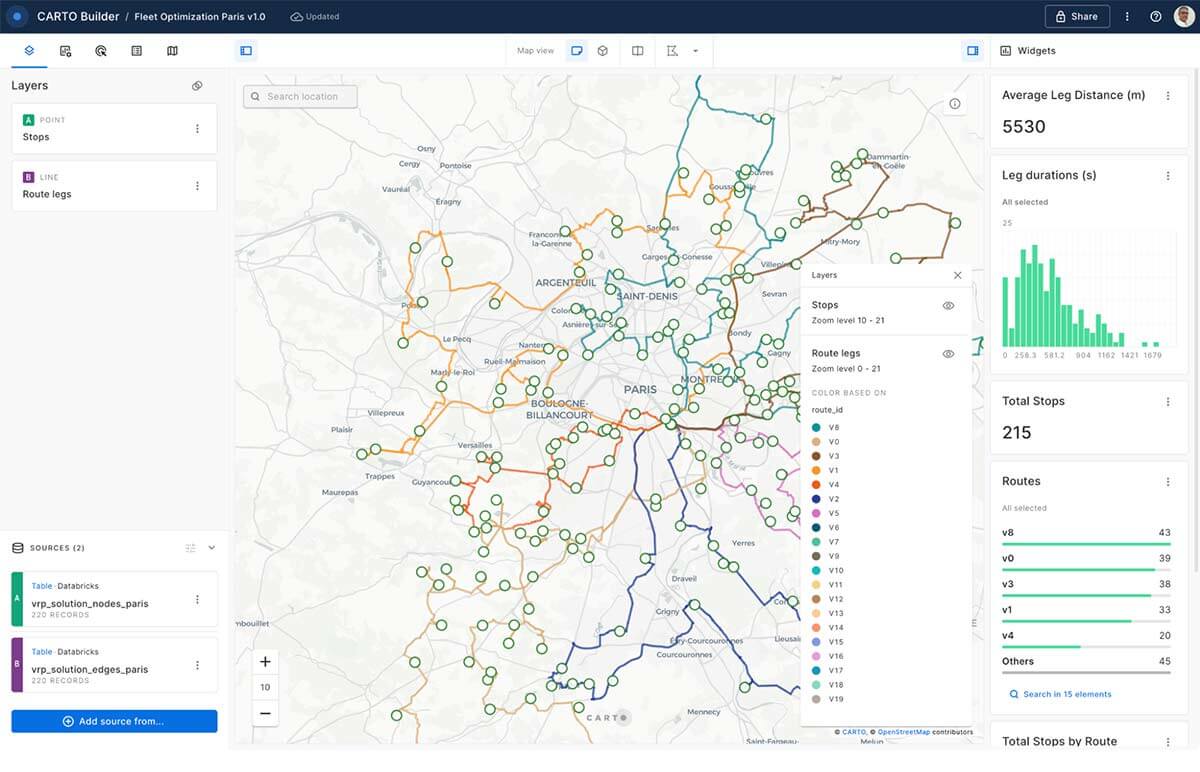Efficient supply has grow to be more and more necessary for companies in recent times, significantly for logistics corporations and people within the shopper packaged items (CPG) trade which have their very own distribution networks.
An enormous problem for these corporations is optimizing transportation routes to reduce prices whereas guaranteeing well timed supply. This entails contemplating components similar to distance, visitors, street circumstances and the kind of transportation used (e.g., truck, rail, air). Moreover, CPG and logistics corporations should contemplate the environmental influence of their transportation selections and intention to cut back their carbon footprint. With will increase in gas costs and intensifying competitors, it’s essential for these organizations to develop clear plans to grow to be extra sustainable, tackle transportation points, and decrease total supply prices.
Routing software program is a key software that helps corporations to deal with these challenges by:
- Planning higher routes, lowering total gas consumption and upkeep bills
- Optimizing supply instances to prospects
- Getting clear, up-to-date insights on the supply community, together with a graphical illustration of routes in a geographical context
- Utilizing quantitative evaluation of routes by way of a set of Key Efficiency Indicators
- Benefiting from extra information sources similar to street visitors and climate information as a part of a constraint-based optimization strategy
Learn on to learn the way Databricks and our associate CARTO may also help you optimize your logistics technique, making your supply processes and routes extra environment friendly and cost-effective.
The Automobile Routing Downside
The Automobile Routing Downside, or VRP, is a category of optimization issues by way of which we attempt to discover essentially the most optimum routes for a fleet of automobiles to go to a set of places whereas satisfying completely different constraints. From an analytical perspective, when coping with VRP, now we have to contemplate many various constraints as outlined within the following desk:

VRP is a generalization of an easier use case, the touring salesperson drawback (TSP):
If we had a variety of cities to go to, what could be the shortest path to go precisely one time by every metropolis and are available again to the unique metropolis?
Within the TSP, now we have a single automobile that has to go to all cities within the shortest doable route with the one constraint being not visiting the identical metropolis twice. The principle distinction between TSP and VRP, is that in VRP we contemplate a fleet, as an alternative of a single automobile, and must consider a collection of extra constraints.
VRP = Areas + Automobile fleet + Constraints + Magnitudes to optimize
VRP issues are various in scope and complexity, and canopy many eventualities outlined beneath:
That is only a number of the choices obtainable. And to additional complicate issues, new VRPs might be outlined utilizing a mix of all the above.
Of their common type, VRP issues are difficult to unravel! They belong to a class referred to as NP-hard issues. The time required to unravel these issues will increase quickly with the scale of their enter information.
A naive strategy to fixing a VRP could be:
1- Compute all of the doable options as mixtures of automobiles and places they go to
2- Discard the options that don’t fulfill the constraints
3- Compute some type of rating to measure how good every answer is
4- Choose the answer with greatest rating
Because the variety of automobiles and places to go to will increase, the variety of mixtures of routes grows factorially. For instance, let’s suppose now we have a pc capable of carry out 1.000.000.000 operations in a second. Let’s examine how a lot time would take to unravel completely different sizes of VRP’s:
| Areas to go to | Operations required | Time required |
|---|---|---|
| 5 | 5! = 120 | 0.00000012 seconds |
| 10 | 10! = 3628800 | 0.004 seconds |
| 15 | 15! = 1307674368000 | 22 minutes |
| 20 | 20! = 2.4329E+18 | 4628 years |
| 25 | 25! = 1.55112E+25 | 295 million years |
It’s not uncommon to seek out actual circumstances wherein the variety of places to go to is a number of thousand. So it’s clear that to seek out options for VRPs, now we have to make use of strategies that present options that won’t essentially be one of the best, however that may be computed in a shorter period of time. Even when we apply methods to simplify/partition our drawback, there’s nonetheless the necessity for scaling up the processing. Databricks Lakehouse platform naturally matches the number of wants {that a} advanced drawback like VRP poses.
A number of libraries implement VRP algorithms and permit us to develop software program to optimize routes for automobile fleets. However constructing these options from scratch isn’t a straightforward process. Even making use of those obtainable libraries entails the next issues:
- Totally understanding the routing library requires a steep studying curve. Our answer gives an abstraction layer and simplifies the tip to finish journey from the issue assertion to VRP answer.
- VRP is resource-hungry and cautious administration of computational sources is required to deploy an enterprise scale utility:
- Scaling and cargo balancing. Databricks Lakehouse platform generally is a highly effective ally in VRP, the place a excessive computing energy is required, however solely throughout sure time slots.
- Resiliency. Databricks being a PaaS cloud providing abstracts the necessity to deal with resiliency manually by the tip customers, the platform takes care of guaranteeing sources can be found and that VRP might be run on demand.
- Further features aside from the VRP should even be taken under consideration:
- Graphical illustration of knowledge in a geographical context. Integration between CARTO and Databricks gives an awesome combine between scalable compute and interactive geospatial UI.
- Further insights similar to charts or metrics that present key efficiency indicators in regards to the efficiency of the answer. MLFlow gives a set of capabilities to collate completely different features of VRP options and produce a complete audit path.
Introducing Carto’s Fleet Optimization Answer utilizing Databricks
To handle this advanced spatial drawback, CARTO gives a fleet optimization toolkit that permits builders to take full benefit of the highly effective and elastic computing sources of Databricks to design routing purposes that assist corporations to be extra environment friendly, aggressive and environment-friendly.
CARTO’s routing answer gives a number of ready-made parts. Totally different components of this framework might be outlined, permitting customers to set the precise particulars of the routing drawback.
The next diagram depicts the method of fixing a routing drawback utilizing the CARTO routing module on Databricks.

These are the primary parts of the answer:
- Automobile Routing Algorithm. Computes legitimate options for the VRP it’s fed as its enter.
- Routing Mannequin. Incorporates the issue setting, together with stops, constraints, route price matrix and the whole lot else the routing algorithm wants as enter
- Cartography Supplier. Supplies the visitors maps that can be used to find out the journey path between each pair of stops in the issue.
- Location Clustering. Arranges places which might be close to sufficient into teams referred to as “stops”, as a way to cut back the scale of the issue. Totally different clustering algorithms might be outlined.
- Constraint Configuration. Creates constraints from Time Home windows and drivers, as a way to add them to the routing mannequin.
- Answer Repository. After the routing algorithm has ended efficiently and an answer has been computed, it may be saved in a Answer Repository like Delta Lake.
Here’s a pattern code that could possibly be used to design an purposes with these parts:
- First code instance. Getting ready community information.
""" Obtain geographic information from Open Avenue Map and course of it to get hold of the community to compute distance matrices. This code could possibly be run on a periodic foundation, as a way to have community information updated (each day, weekly, month-to-month), however as now we have it saved on DBFS, it may be reused as many instances as we'd like while not having to re-run the script. """ from carto_vrp.osm import OSMDataset from carto_vrp.community import Community # Choose the geographical space of the information to be downloaded osm_pbf_url = 'http://obtain.geofabrik.de/europe/france/ile-de-france-latest.osm.pbf' # Obtain dataset from OSM as community supplier osmd = OSMDataset(osm_pbf_url) # We'll retailer community information in DBFS output_folder = '/dbfs/FileStore/routing_optimization_data/paris' # Instantiate community builder ntwk = Community(osmd) ntwk.construct(output_folder) # from this level, community information is offered on the DBFS output folder - Second code instance: fixing a fleet optimization drawback:
""" Load a VRP dataset and community information and generate an answer. The VRP dataset contains jobs (i.e. deliveries), automobiles and a depot. The community information gives all the knowledge wanted to compute journey prices between completely different places. VRP dataset and answer are saved in Delta Lake. """ from carto_vrp.drawback import VehicleCostMatrix from carto_vrp.repository import VRPRepositoryDelta, VRPSolutionRepositoryDelta from carto_vrp.routing_algorithms import VehicleRoutingAlgorithm from carto_vrp.routing_engine import RoutingEngine from carto_vrp.automobile import Automobile import mlflow # Loading dataset from Delta Lake tables from Delta Lake. # We offer a spark session and three tables from which recuperate # Jobs, Automobiles, Metadata, together with depot location vrp_repository = VRPRepositoryDelta(spark, 'carto_data.vrp_jobs_paris', 'carto_data.vrp_vehicles_paris', 'carto_data.vrp_metadata_paris') vrp_dataset = vrp_repository.load() # Instantiate a RoutingEngine, the interface to community information network_data = '/dbfs/FileStore/routing_optimization_data/paris/paris-latest.osrm' routing = RoutingEngine({Automobile.DEFAULT_VEHICLE_TYPE: network_data}) # Compute a price matrix based mostly on community information supplied cost_matrix = VehicleCostMatrix(routing, vrp_dataset) # Instantiate the algorithm to seek out the answer to the VRP assertion algorithm = VehicleRoutingAlgorithm(vrp_dataset, cost_matrix) answer = algorithm.search_solutions() # this gives a brief digest of the VRP answer obtained print(answer) # use mlflow to retailer metadata in regards to the VRP answer with mlflow.start_run(): mlflow.log_param("municipality", "Paris") mlflow.log_param("network_data_location", network_data.dataset_name) mlflow.set_tag("solution_digest", answer.abstract) # Now, we are able to retailer the answer in Delta Lake, from which # we are able to use CARTO to show it graphically solution_repo = VRPSolutionRepositoryDelta(routing, 'carto_data.vrp_nodes_paris', 'carto_data.vrp_edges_paris') solution_repo.save(answer)
Within the examples above now we have demonstrated how easy it’s to construct the code for a VRP answer utilizing CARTO’s routing answer. By means of seamless integration with Databricks Lakehouse platform these options can simply be scaled up and we are able to run many VRP issues in parallel utilizing Databricks scalable compute, on the identical time we are able to simply hold observe of various subproblems utilizing MLFlow to collate the metadata about completely different runs.
Instance use case: a CPG firm delivering to numerous retailers
As an instance the significance of efficient supply and logistics for CPG corporations, let’s contemplate a sensible use case of a CPG firm with its personal distribution community. The CPG firm locations a variety of merchandise to be delivered to their varied retailers on a given due date, with most of those merchandise having a particular time window for supply.
To optimize its distribution community, the corporate estimates the variety of automobiles required to ship all of the merchandise and goals to optimize their transportation routes to reduce prices whereas guaranteeing well timed supply.
The answer to the VRP has to think about many extra features similar to:
| Automobiles |
|
| Merchandise |
|
| Depots |
|
Our fleet consists of a variety of automobiles and their drivers. They have to go from the depot to the retailers, thus describing routes. We have some issues we have to optimize: we wish to ship as many merchandise as doable, in as little time as doable, and with as few automobiles as doable. We have additionally received a number of constraints we have to work with, just like the supply time home windows, driver work shifts, and automobile capability.
Day by day, within the early morning, we run the fleet optimization course of to unravel the each day VRP. Consequently, we get hold of a set of routes that our drivers ought to take, with a pleasant map to assist visualize them. We additionally get an inventory of the stops we should make and the merchandise we’ll ship at each. Every route is assigned to a particular automobile, and we are able to observe a number of KPIs to assist us see how we’re doing. For instance, we are able to see what number of stops we made in whole and the common distance every route leg covers. Moreover, we are able to view a histogram graph to symbolize the route leg durations.

Good route optimization can present the corporate with a aggressive benefit. By optimizing their distribution community, they will provide quicker, less expensive and extra dependable supply than their opponents, which may also help them improve market share.
If you wish to see how the CARTO & Databricks fleet optimization answer might be utilized to your use case, do not hesitate to attain out!
